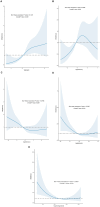The independent and combined effects of blood heavy metal concentrations on all-cause mortality and cardiovascular mortality in adult patients with diabetes mellitus
- PMID: 40538685
- PMCID: PMC12176894
- DOI: 10.3389/fpubh.2025.1588078
The independent and combined effects of blood heavy metal concentrations on all-cause mortality and cardiovascular mortality in adult patients with diabetes mellitus
Abstract
Background: Most epidemiological studies have focused on the association between single metal exposure and cardiovascular disease risk, utilizing a single-pollutant model for analysis. However, multiple metals may interact with each other, leading to misjudgment of health risks. This study sought to ascertain both the independent and combined effects of various blood heavy metal concentrations on all-cause mortality and cardiovascular mortality in patients with DM.
Methods: Patients (≥20 years) with DM from the NHANES (2011-2018) were selected. To explore the relationships of exposure to individual metals, including cadmium (Cd), mercury (Hg), manganese (Mn), lead (Pb), and selenium (Se), with all-cause mortality and cardiovascular mortality, weighted logistic regression and RCS analysis were leveraged. The WQS model was utilized to estimate the effects of combined blood metal exposures.
Results: 1,798 patients with DM were included. In the unadjusted model, ln-transformed blood Pb level (OR = 2.3, 95% CI: 1.70-3.10, p < 0.001) and ln-transformed Cd level (OR = 1.54, 95% CI: 1.27-1.87, p < 0.001) demonstrated positive associations with the all-cause mortality risk. According to RCS analysis, a nonlinear dose-response relationship was noted between Pb, Cd, Se, and the all-cause mortality risk (p-nonlinear < 0.05), while Hg and Mn showed linear relationships (p-nonlinear > 0.05).
Conclusion: According to this study, a high blood concentration of a combination of heavy metals is a significant risk factor for both cardiovascular disease and all-cause mortality of patients with diabetes, with Pb contributing a relatively higher proportion to these risks.
Keywords: all-cause mortality; cardiovascular mortality; diabetes mellitus; environmental health; heavy metals in blood.
Copyright © 2025 Cai, Yan, Sun and Dan.
Conflict of interest statement
The authors declare that the research was conducted in the absence of any commercial or financial relationships that could be construed as a potential conflict of interest.
Figures





Similar articles
-
Association between blood heavy metal levels and COPD risk: a cross-sectional study based on NHANES data.Front Public Health. 2025 Jul 18;13:1494336. doi: 10.3389/fpubh.2025.1494336. eCollection 2025. Front Public Health. 2025. PMID: 40756396 Free PMC article.
-
Association between exposure to blood heavy metal mixtures and overactive bladder risk among U.S. adults: a cross-sectional study.Front Public Health. 2025 Jun 4;13:1597321. doi: 10.3389/fpubh.2025.1597321. eCollection 2025. Front Public Health. 2025. PMID: 40535431 Free PMC article.
-
The association of obesity and lipid-related indicators with all-cause and cardiovascular mortality risks in patients with diabetes or prediabetes: a cross-sectional study based on machine learning algorithms.Front Endocrinol (Lausanne). 2025 Jun 2;16:1492082. doi: 10.3389/fendo.2025.1492082. eCollection 2025. Front Endocrinol (Lausanne). 2025. PMID: 40529828 Free PMC article.
-
Drug-eluting stents versus bare-metal stents for acute coronary syndrome.Cochrane Database Syst Rev. 2017 Aug 23;8(8):CD012481. doi: 10.1002/14651858.CD012481.pub2. Cochrane Database Syst Rev. 2017. PMID: 28832903 Free PMC article.
-
Drugs for preventing postoperative nausea and vomiting in adults after general anaesthesia: a network meta-analysis.Cochrane Database Syst Rev. 2020 Oct 19;10(10):CD012859. doi: 10.1002/14651858.CD012859.pub2. Cochrane Database Syst Rev. 2020. PMID: 33075160 Free PMC article.
References
MeSH terms
Substances
LinkOut - more resources
Full Text Sources
Medical

